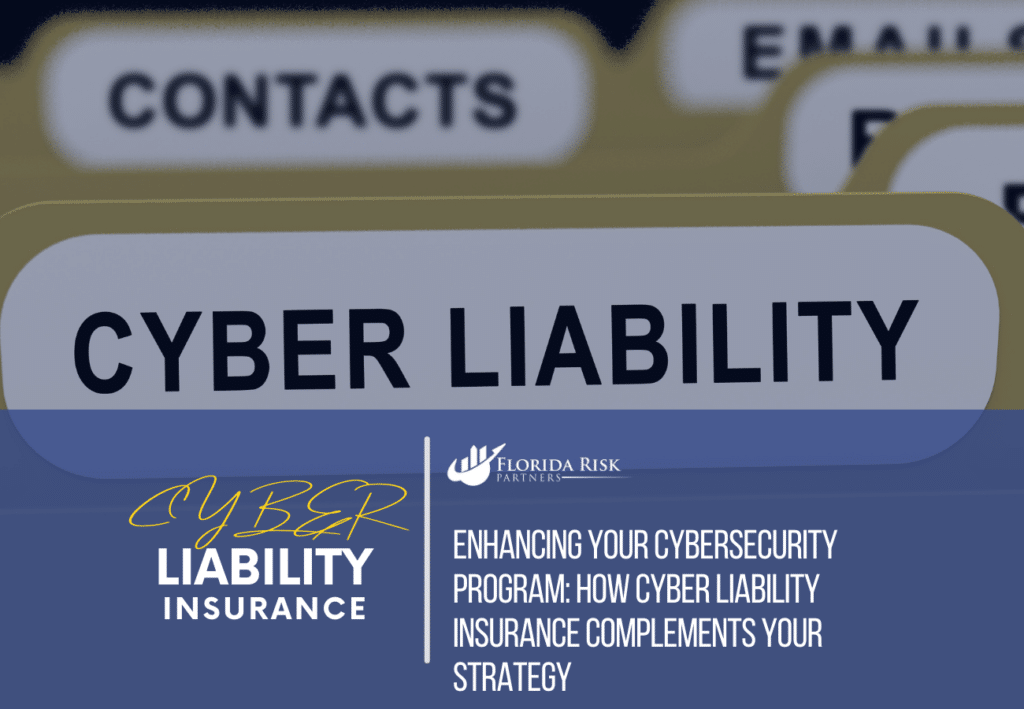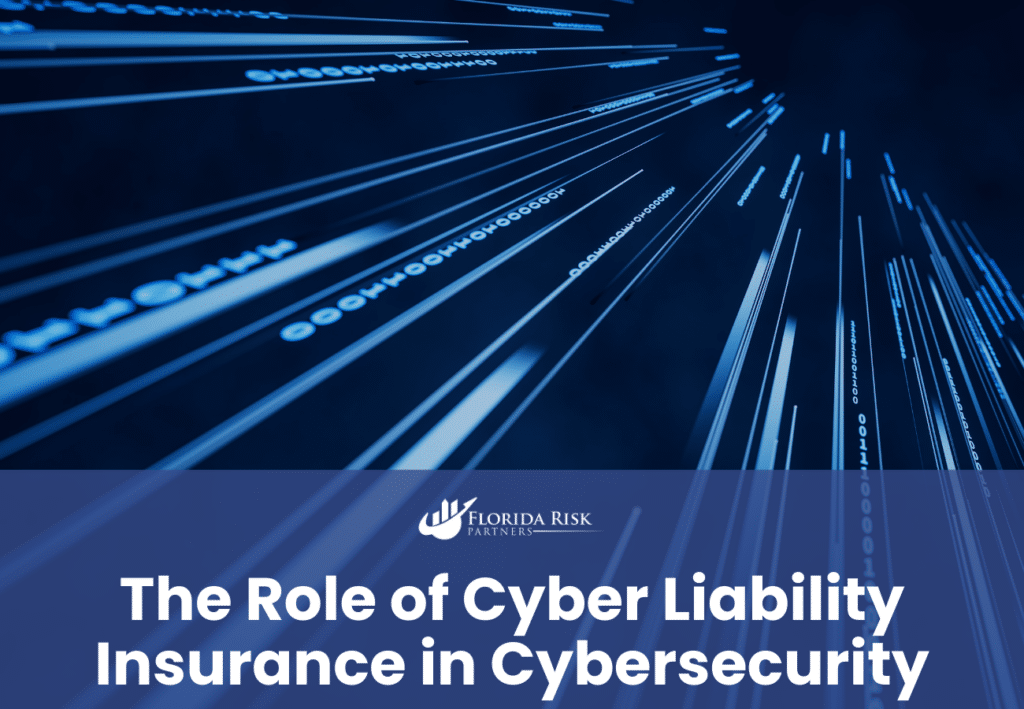-
Main Office: 1434 E. Bloomingdale Ave Valrico, FL 33596-6110
-
Phone: (888) 601-6660
-
Email: info@floridariskpartners.com

Cyber threats are becoming increasingly sophisticated, and businesses must adopt a proactive approach to protect their digital assets. While firewalls, encryption, and employee training are critical components of a cybersecurity program, they are not fail-proof. When a cyber incident occurs, the financial and operational fallout can be severe, making cyber liability insurance an essential part of your cybersecurity strategy.
In this guide, we’ll explore how to enhance your cybersecurity program and how cyber liability insurance complements these efforts. By integrating preventive measures with financial protection, you can build a resilient defense against the evolving landscape of cyber threats.
Why a Comprehensive Cybersecurity Program is Essential
A robust cybersecurity program is no longer optional—it’s a necessity for businesses of all sizes. Cyber incidents such as ransomware attacks, phishing scams, and data breaches can result in:
- Financial Losses: Costs associated with data recovery, legal fees, and fines.
- Reputational Damage: Loss of customer trust and brand credibility.
- Operational Disruptions: Downtime that halts revenue-generating activities.
The key to minimizing these risks is a combination of proactive measures to prevent incidents and reactive tools to address them when they occur. Cyber liability insurance serves as the ultimate safety net, ensuring your business can recover quickly and effectively.
Building a Strong Cybersecurity Program
Before exploring the role of cyber liability insurance, it’s important to understand the foundational elements of a strong cybersecurity program. These measures form the first line of defense against cyber threats.
Conduct Regular Risk Assessments
A cyber risk assessment helps you identify vulnerabilities in your systems, processes, and personnel. By understanding your weaknesses, you can prioritize efforts to mitigate risks effectively.
Steps to Conduct a Risk Assessment:
- Inventory your digital assets, including sensitive data, software, and hardware.
- Identify potential threats, such as phishing, malware, or insider breaches.
- Evaluate the likelihood and impact of each threat.
- Develop a plan to address high-priority vulnerabilities.
Invest in Advanced Cybersecurity Tools
Technology is a critical component of any cybersecurity program. Modern tools can help detect, prevent, and respond to cyber threats.
Essential Tools to Consider:
- Firewalls and Antivirus Software: Block unauthorized access and malware.
- Intrusion Detection Systems (IDS): Monitor network traffic for suspicious activity.
- Data Encryption: Protect sensitive information from unauthorized access.
- Endpoint Protection: Secure devices such as laptops, tablets, and smartphones.
Why This Matters:
These tools provide a baseline level of protection, reducing the likelihood of a successful attack.

Train Your Employees
Human error is one of the leading causes of cyber incidents. Employees may click on phishing links, use weak passwords, or inadvertently share sensitive information. Regular training can mitigate these risks.
Training Topics to Cover:
- Recognizing phishing emails and other social engineering tactics.
- Creating strong, unique passwords and using a password manager.
- Following company policies for data sharing and storage.
- Reporting suspicious activity promptly.
Why This Matters:
Educated employees act as the first line of defense, preventing many common cyber threats.
Develop an Incident Response Plan
Even with strong preventive measures, no system is immune to cyberattacks. An incident response plan ensures your team knows exactly how to act when an incident occurs.
Key Elements of an Incident Response Plan:
- Clear roles and responsibilities for team members.
- Steps to contain the threat, such as isolating affected systems.
- Communication protocols for notifying stakeholders, including customers and regulators.
- Guidelines for activating your cyber liability insurance policy.
Why This Matters:
A well-defined plan minimizes confusion and ensures a swift, coordinated response.
The Role of Cyber Liability Insurance in Cybersecurity
While a strong cybersecurity program reduces the likelihood of a cyber incident, it can’t eliminate the risk entirely. Cyber liability insurance fills the gaps, providing financial protection and access to professional resources when preventive measures fall short.
Financial Protection for Cyber Incidents
Cyber liability insurance covers a wide range of costs associated with cyber incidents, including:
- Data Recovery: Expenses to restore lost or corrupted data.
- Business Interruption: Compensation for lost revenue during downtime.
- Ransomware Payments: Coverage for ransom demands (where legally permitted).
- Legal Defense: Attorney fees and court costs if your business is sued.
- Regulatory Fines: Penalties for non-compliance with data protection laws.
Why This Matters:
Without insurance, these costs can quickly overwhelm your business, particularly if you’re a small or mid-sized company.
Access to Incident Response Services
Many cyber liability policies include access to incident response resources, such as:
- Forensic Experts: Professionals who investigate the cause and scope of the incident.
- Public Relations Specialists: Experts who manage communications to protect your reputation.
- Legal Counsel: Attorneys who ensure compliance with notification laws and regulatory requirements.
Why This Matters:
Having access to these resources ensures a faster, more effective response to a cyber incident, minimizing its impact on your business.

Bridging Coverage Gaps
Traditional insurance policies, such as general liability or property insurance, typically exclude cyber risks. This insurance addresses these exclusions, providing comprehensive protection against digital threats.
Examples of Coverage Gaps:
- General Liability Insurance: Covers physical injuries and property damage, not data breaches.
- Property Insurance: Protects physical assets like buildings, not digital assets like data.
- Errors and Omissions Insurance: Covers professional mistakes but excludes damages from cyber incidents.
Why This Matters:
Cyber liability insurance ensures your business is fully protected, even in scenarios where traditional policies fall short.
Integrating Cyber Liability Insurance with Your Cybersecurity Program
The most effective way to protect your business is to integrate cyber liability insurance into your broader cybersecurity strategy. Here’s how to do it:
Align Coverage with Your Risks
Use the findings from your cyber risk assessment to select a policy that addresses your specific vulnerabilities. For example, if ransomware is a major concern, ensure your policy includes robust ransomware coverage.
Incorporate Insurance Into Your Incident Response Plan
Familiarize your team with the resources provided by your cyber liability policy, such as breach response teams or forensic experts. Include steps for activating your policy in your incident response plan.
Review and Update Regularly
As your business evolves, so do your cyber risks. Review your cybersecurity measures and insurance coverage annually to ensure they remain aligned with your needs.
Take the Next Step Toward Cyber Resilience
In today’s digital world, a comprehensive cybersecurity program is essential for protecting your business from cyber threats. By combining proactive measures with the financial protection of cyber liability insurance, you can minimize risks and ensure your business is prepared to recover from any incident.
To learn more about how this insurance can enhance your cybersecurity strategy, read our detailed guide: What Does Cyber Liability Insurance Cover?. This resource provides a comprehensive overview of the coverage options and benefits available to your business.
Download Our Complimentary Guide to Purchasing Cyberliability Insurance
Don’t wait for a cyber incident to test your defenses—start building a resilient cybersecurity program today.
Call Us Or
Schedule an Appointment
Select an agent below to view our online calendars and select a day and time that works best for you or call us directly at 888-601-6660. When you use our online calendars, you will receive an email with more information.



